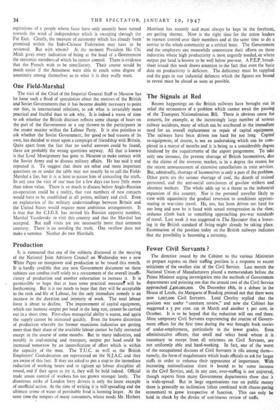Fewer Civil Servants ?
The directive issued by the Cabinet to the various Ministries to prepare reports on their staffing position is a response to recent criticisms of the swollen size of the Civil Service. Last month the National Union of Manufacturers placed a memorandum before the Prime Ministei urging investigation into the methods of Government departments and pointing out that the annual cost of the Civil Service approached fAco,000,000. On December 18th, in a debate in the House of Lords, the Marquess of Reading pointed out that there were now r,007,000 Civil Servants. Lord Chorley replied that the position was under " constant review," and now the Cabinet has suggested a 5 per cent. cut in March and another 5 per cent. in October. It is to be hoped that the reduction will not end there. Most temporary Civil Servants experiencing the routine of Govern- ment offices for the first time during the war brought back stories of under-employment, particularly in the lower grades. Even administrative officers, that small and select band whom it is . customary to except from all strictures on Civil Servants, are not uniformly able and hard-working. In fact, one of the worst of the occupational diseases of Civil Servants is rife, among them-- namely, the form of megalomania which leads officials to ask for larger staffs in order to enhance their appearance of importance. With increasing nationalisation there is bound to be some increase in the Civil Service, and, in any case, over-staffing is not universal, though reports from many Government departments show that it is wide-spread. But in large organisations run on public money - there is generally an inclination (often combined with cheese-paring economies) to grow irrespective of function. This can only' be held in check by the device of continuous review of staffs.


































 Previous page
Previous page